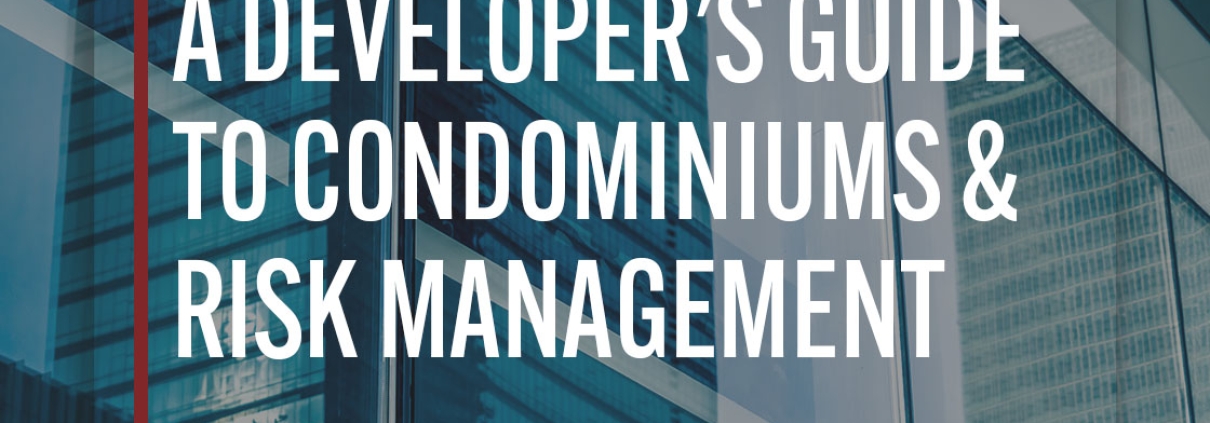Condominiums and Risk Mitigation: A Developer’s Guide
The increase in demand for the condominium experience entices more and more developers to contemplate starting their own condo projects. If you are one of them, keep in mind that condo construction comes with a marked increase in litigation risk for the design, development, and construction teams involved. These claims range anywhere from contract disputes to professional malpractice. It is possible to minimize this risk and ensure a successful project, but it’s a good idea to review some of the condominium guidelines and regulations to watch for during the design and building process. Continue reading to learn about condominiums and helpful risk mitigation.
4 Common Causes of Condominium Litigation
Multi-family industry experts agree that while apartment complexes come with a high chance of litigation, the risk is astronomical with condominium developments. Individual owners and Homeowner Associations (HOAs) file disputes for numerous reasons, including odors, leaks, cracks, and equipment defects. In many cases, these claims are meritless, but that does not avoid the cost of dealing with them in the first place. With proper due diligence, architects, developers, and general contractors can significantly reduce their chances of finding themselves in the middle of a lawsuit. Most legal claims fall into one of four main categories:

CONSTRUCTION DEFECTS
Many of these lawsuits revolve around construction defects involving cracks, leaks, or drainage issues in commonly owned elements or undivided portions of the condominium building, such as windows, roofs, driveways, and building exteriors. These suits are often based on negligence or breach of express, implied, or statutory warranties.
CONTRACT DISPUTES
Disparities over payment and performance, or non-performance, are probably the most common contract disputes that wind up in litigation. However, you will find that warranty claims, indemnification claims, and other contract-based claims are also prevalent.
PROFESSIONAL MALPRACTICE
Architects, engineers, and others involved in a condominium construction project are all open to malpractice suits. Substandard design can lead to structural or other issues and entitle HOAs to seek retribution for professional malpractice.
IMPLIED WARRANTIES
In addition to contractual warranties, all condominium projects are also subject to implied warranties (i.e., conforms to an ordinary buyer’s expectations, whether written or not). Unless implied warranties have been validly disclaimed (which is not always easy to do since implied warranty law varies from state to state), they can provide additional causes for action by condo associations. Be sure to review all marketing materials to ensure the brand message sets realistic expectations.
How Jordan & Skala Helps to Mitigate Risks for Condo Developers

A ROBUST DESIGN
Ensuring that you have a top-notch condo design lowers the risk of a claim or litigation. The overall intent of the entire team (developer, designers, contractors) should be to create a structure of the highest quality, and the process should be as transparent as possible. The design team should avoid making assumptions and present all options to the developer. The developer must be comfortable making well-informed decisions, such as whether or not to bring in additional equipment or incorporate higher-end materials and aesthetics.
Some items that need to be at the forefront of consideration are those relating to occupant comfort and the human senses. This includes anything that affects smell, temperature, lighting, water, taste, feeling, and sight. It is well known that mechanical, electrical, and plumbing systems can significantly affect the occupant’s condo experience within the building. Additional attention applied to these areas can keep occupants happy, and happy occupants tend to not file complaints. Also, some of the most common issues brought up in condo litigation are water leakage and sound transmission. It’s in the developer’s best interest to pay particular attention to these areas as much as possible during the design phase.
PREMIUM LEVEL OF SERVICE
As detailed below under Design & Quality Control, a more robust design and documentation process, and added attention to detail coupled with the additional risk of condominium liabilities, requires more time from experienced senior staff on the condo engineering team. It should be noted that the required experience level of senior staff and the extra effort of all involved in the project will result in an above-average labor cost. But this cost is justified in the level of care and commissioning required for the project.
INSURANCE POLICIES
Having a good condo MEP engineering firm on your side goes a long way towards reducing condo litigation risk. While there are ways to reduce the likelihood of litigation, you cannot completely eliminate it. Some law firms target the construction industry specifically to file expensive lawsuits for insurance companies to settle. So, more likely than not, a claim will come up against the developer, the contractor, and the design team.
Because of this increased risk of litigation, Jordan & Skala Engineers recommends having a comprehensive, project-specific insurance policy in place to give some financial protection to the entire team (developer, construction and design). It is common for these types of “wrap” policies to protect the developer and construction team, but they typically leave out the design team (architects and engineers) unless specifically negotiated. Be sure to budget for a policy that also includes the design team to reduce headaches and costs later down the line.
CONTRACTUAL ITEMS
Making sure you have broad contractual items within the Terms and Conditions in place when quoting a project gives you a great deal of protection. Consider including the following:
- Ensure that the HOA is contractually required to have a two-thirds vote from tenants before bringing a claim.
- Structure contracts to preclude claims against the design and construction teams for issues related to anything that has been constructed or implemented against their written recommendations.
- Enact time limits for bringing specific claims against the project. Time limits can avoid frivolous lawsuit filings from being brought just as any Statute of Limitations is due to expire.
- Request that all prospective condo buyers have their unit inspected by a qualified professional prior to purchase and agree to accept the unit “as-is.” Any issues that arise during the inspection will be fixed before closing.
- Create a maintenance manual and transfer it to the condo association with requirements that all requirement maintenance be conducted on a regular basis and well documented prior to filing any claims.
Once the Developer finalizes the Terms and Conditions, all project partners should review the contracts and make sure they understand each other’s roles and scopes of work.
PROPER DOCUMENTATION
The value of proper documentation cannot be overstated. Having the supporting documents to back up decisions made will prove invaluable when dealing with condominium liabilities. The Developer should well document every aspect of every phase of construction. Jordan & Skala highly recommends an increased level of quality control, such as:
- Including more detail in condo designs and notations.
- Increasing the number of site visits over typical multi-family projects.
- Implementing a greater level of enhanced commissioning to confirm that all systems are installed and functioning as intended.
- Ensuring that all applicable contracts and manuals are in their proper place to assist with maintaining the building over the years.
Having a stringent documentation process will help you sufficiently vet essential items throughout all phases of design and construction.
Other Important Considerations

A FAVORABLE LOCATION AND STRONG WORKFORCE
Where you decide to build can be a critical factor in the overall quality of your project. For example, highly qualified labor can be difficult to find in coastal areas or small towns located outside of an urban area. Unfortunately, unskilled labor often results in poor workmanship. All contractors and subcontractors should be thoroughly vetted and their references checked. Quality of workmanship becomes even more important if the location has a challenging environment.
For example, coastal and tropical climates can place undue stress on HVAC systems and the building envelope due to high humidity. If the condominium is located in a high seismic zone, there is an increased risk of structural cracks, leaks, and cosmetic damage. Seismic activity can also cause windows and doors to shift, leaving the building vulnerable to water infiltration. These are precisely the types of things that can move a condo association to action in an attempt to recoup their repair costs.
Another thing to consider is that resort locations or areas with mostly seasonal occupancies have tenants who leave their units unoccupied for long periods. These well-meaning occupants often turn off their HVAC systems or leave them in a state detrimental to their units’ long-term condition. This can result in mold growth and other damage, which is also highly likely to lead to damage claims.
DESIGN AND QUALITY CONTROL
During a condo construction project, it’s good to increase the number of site visits and implement a higher level of coordination and design whenever possible. These projects often merit a premium fee because it is time-consuming to achieve risk mitigation for condos. The following are our suggestions for what to focus on:
- Hire a highly skilled and qualified general contractor you can trust. Doing so allows for adequate delegation and creativity through design and construction.
- Document the contractor’s progress as much as possible. One technique that has grown in popularity is to use photographic and video documentation throughout the construction process. For example, a Developer might take photos of every window and door’s waterproofing elements before they are covered up. Having these photos on hand could be a critical piece of evidence in a defect lawsuit brought on later.
- All waterproofing and acoustical specifications should be directed by a specialized consultant and implemented by a qualified contractor.
- Collaborate with a fire protection professionals on all life safety items. Smoke and fires pose a significant risk and can quickly turn into lawsuits.
- Even where testing is not required by building code, test for duct tightness and envelope pressurization on all units.
- Submit the architecture and engineering drawings and specifications for a third-party peer review. A second or third pair of eyes on your plans allows an independent architect or engineer the opportunity to find errors and offer potential ideas for improvement.
THE RISK OF MANY UNITS
It’s the law of averages, but the greater the number of units you have, the more opportunities for design or construction problems to arise. You can minimize this risk by using a qualified team to thoroughly inspect all units throughout each phase of construction. Many claims are related to construction defects, so it’s imperative that developers work only with experienced architects who include flashing, penetration, and waterproofing details specific to residential condos in their plans. Once construction is complete, create a maintenance manual and transfer it to the condo association.
BUDGET FOR SUCCESS
Don’t find yourself at the mercy of an inadequate budget. Lack of funds often drives developers and contractors to cut costs instead of adopting the best practice or opting for a better-designed system that is more in line with a condominium project’s rigorous demands. This lack of foresight often leads to system failures and leaves developers open to litigation. Working through condominium construction is never the ideal time to cut corners on any part of the project.
Ready to Begin Your Condo Development?
Now that you have a better idea of what’s involved with condominiums and risk mitigation, in terms of development and design, take a step back and consider your level of interest. Developing condominiums may result in paying a higher fee to secure senior-level engineering and defending a claim from an aggressive attorney and HOA. But with a good team on your side, including top MEP engineers, a few good attorneys, and construction insurance brokers, you’ll have the tools you need to move through the process smoothly and complete your next condo project successfully. Contact Jordan & Skala Engineers today to discuss your next condominium or multi-family project.












Leave a Reply
Want to join the discussion?Feel free to contribute!